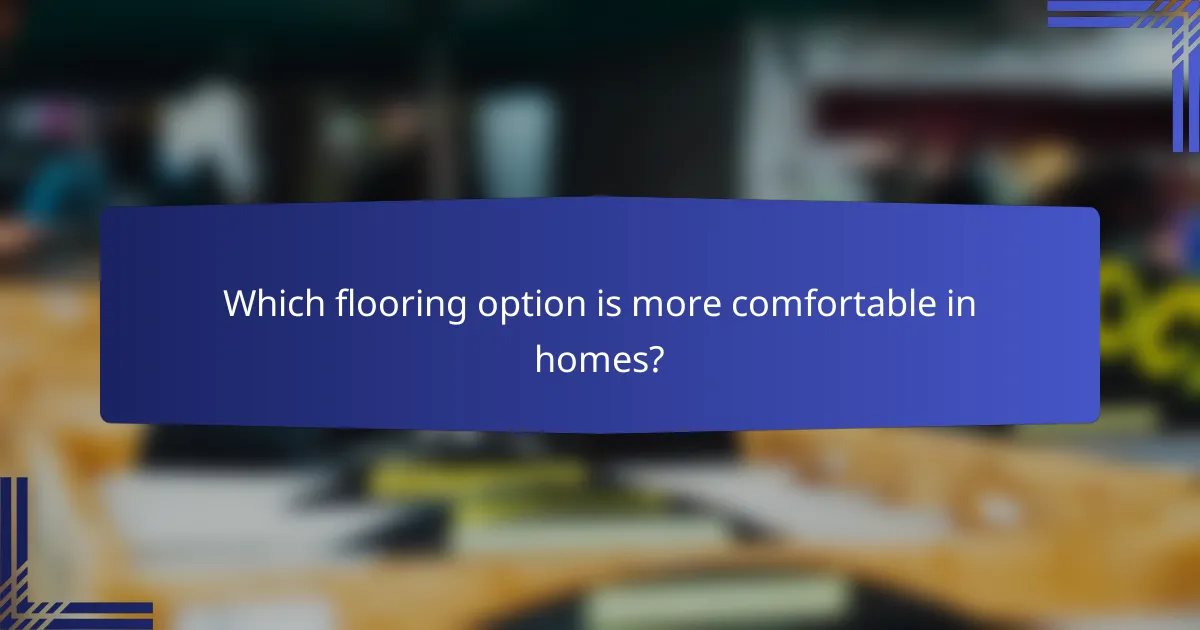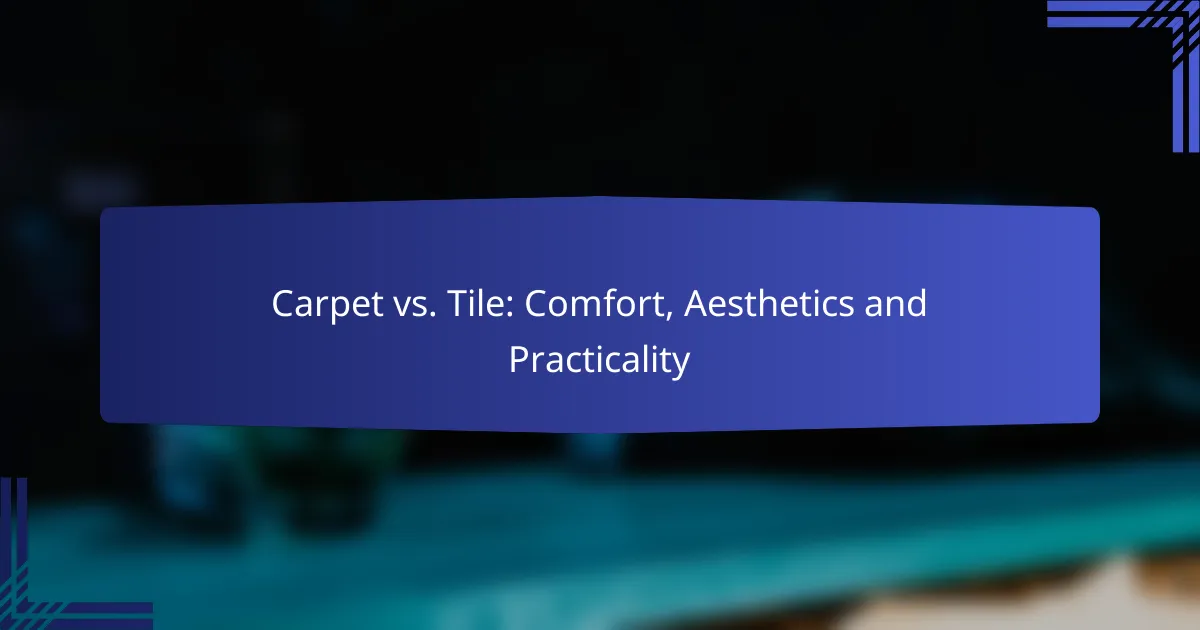When choosing between carpet and tile for your home, comfort, aesthetics, and practicality play crucial roles in the decision-making process. Carpet offers a soft, warm feel underfoot, making it ideal for cozy spaces, while tile provides a sleek, modern look and is easier to maintain. Each flooring option has its unique benefits, catering to different preferences and environmental needs.

Which flooring option is more comfortable in homes?
Carpet is generally considered more comfortable than tile in homes due to its softness and warmth underfoot. However, tile can provide a cooler surface, which may be preferable in warmer climates.
Carpet offers superior softness
Carpet is made from fibers that create a plush surface, making it soft and comfortable to walk on. This softness can be particularly beneficial in areas where people often sit or play, such as living rooms and children’s playrooms.
Additionally, the cushioning effect of carpet can help reduce fatigue on the feet and joints, making it a popular choice for those who spend long periods standing or walking indoors.
Tile provides a cooler surface
Tile flooring tends to be cooler than carpet, which can be advantageous in hot climates. The hard surface of tile can help maintain a lower ambient temperature in a room, making it a preferred option for kitchens and bathrooms where heat can build up.
However, this cooler surface may feel uncomfortable during colder months, especially in regions with harsh winters. Using area rugs can help mitigate this issue while still enjoying the benefits of tile.
Carpet reduces noise levels
Carpet is effective at absorbing sound, which can significantly reduce noise levels in a home. This quality makes it ideal for multi-story homes or apartments, where noise from footsteps can be disruptive to those living below.
In contrast, tile can amplify sound due to its hard surface, making it less suitable for areas where noise control is a priority. If noise reduction is essential, opting for carpet in living areas and bedrooms is advisable.
Tile is easier on allergies
Tile flooring is less likely to trap allergens such as dust, pet dander, and pollen compared to carpet. This makes tile a better option for individuals with allergies or respiratory issues, as it can help maintain better indoor air quality.
Regular cleaning of tile surfaces is straightforward, requiring only sweeping and mopping, which can further reduce allergen buildup. In contrast, carpets may require more intensive cleaning methods, such as steam cleaning, to remove trapped allergens effectively.

How do carpet and tile compare in aesthetics?
Carpet and tile each offer distinct aesthetic qualities that can significantly influence the look and feel of a space. While carpet tends to provide warmth and a variety of colors, tile is often associated with modern, sleek designs that can enhance a contemporary atmosphere.
Carpet provides warmth and color variety
Carpet is known for its ability to create a warm and inviting environment. Available in a wide range of colors and textures, it can complement various interior styles, from traditional to modern. This versatility allows homeowners to express their personal style through their flooring choices.
When selecting carpet, consider factors like fiber type and pile height, as these can affect both appearance and comfort. For instance, plush carpets offer a softer feel, while looped carpets provide durability and a unique texture.
Tile offers modern, sleek designs
Tile flooring is often favored for its clean lines and contemporary look. It comes in various materials, including ceramic, porcelain, and natural stone, allowing for a range of finishes that can suit any design preference. The smooth surface of tile can create a polished and sophisticated aesthetic.
When choosing tile, think about the size and layout of the tiles. Larger tiles can make a space appear bigger, while smaller tiles can be used to create intricate designs or mosaics, adding visual interest to your flooring.
Carpet can create a cozy atmosphere
One of the main advantages of carpet is its ability to foster a cozy and comfortable atmosphere. The soft texture underfoot can make a room feel more inviting, especially in living areas and bedrooms. Carpet also helps with sound absorption, reducing noise levels and enhancing comfort.
For a truly cozy feel, consider using area rugs in conjunction with wall-to-wall carpeting. This combination can add layers of warmth and style, allowing for creative design options.
Tile allows for intricate patterns
Tile provides the opportunity to create intricate patterns and designs that can serve as a focal point in a room. With various shapes and colors available, homeowners can experiment with layouts, such as herringbone or chevron patterns, to add character to their spaces.
When planning a tile layout, consider using contrasting grout colors to highlight the design. This can enhance the visual appeal and make the patterns stand out even more, creating a unique and personalized look.

What are the practical differences between carpet and tile?
The practical differences between carpet and tile primarily revolve around durability, maintenance, and suitability for various environments. While carpet offers warmth and comfort, tile provides resilience and ease of cleaning, making each option better suited for different needs.
Carpet is less durable than tile
Carpet generally has a shorter lifespan compared to tile, often lasting around 5 to 15 years depending on the quality and foot traffic. In contrast, tile can last for several decades when properly maintained, making it a more durable flooring choice for high-traffic areas.
When considering durability, it’s important to factor in the type of carpet fibers and the backing material. Synthetic fibers tend to wear better than natural ones, but even the best carpets will show signs of wear over time, especially in busy households.
Tile is more water-resistant
Tile is inherently more water-resistant than carpet, making it an ideal choice for areas prone to moisture, such as bathrooms and kitchens. Most tiles are made from materials like ceramic or porcelain, which do not absorb water and can withstand spills without damage.
In contrast, carpet can absorb moisture, leading to potential mold and mildew issues if not dried quickly. For homes in humid climates or those with pets, tile offers a significant advantage in maintaining a clean and healthy environment.
Carpet requires regular cleaning
Carpet requires frequent cleaning to maintain its appearance and hygiene, often needing vacuuming multiple times a week and professional deep cleaning every 12 to 18 months. This maintenance can be time-consuming and may incur additional costs over time.
In comparison, tile is much easier to clean, typically requiring only regular sweeping and mopping. For busy households, this lower maintenance can be a significant benefit, allowing for more time to enjoy your space.
Tile can withstand heavy foot traffic
Tile is an excellent choice for areas with heavy foot traffic, such as entryways or commercial spaces, due to its ability to resist scratches and dents. It can handle the wear and tear from daily use without showing significant signs of damage.
Carpet, while comfortable, can become matted and stained in high-traffic areas, necessitating more frequent replacement. For homes or businesses expecting a lot of visitors, tile is a practical and long-lasting flooring solution.

What factors should you consider when choosing flooring?
When selecting flooring, consider factors such as budget, room usage, and climate preferences. Each element influences the comfort, aesthetics, and practicality of your choice, impacting both short-term satisfaction and long-term maintenance.
Budget constraints
Your budget is a primary factor in flooring selection. Carpet typically costs less upfront than tile, with prices often ranging from $10 to $30 per square meter for materials, while tile can range from $20 to $100 or more per square meter, depending on the type and quality.
Consider installation costs as well, which can vary significantly. Professional installation for carpet might cost around $5 to $15 per square meter, while tile installation can be higher due to the complexity, often ranging from $15 to $30 per square meter.
Room usage and foot traffic
The intended use of the room greatly affects flooring choice. High-traffic areas, like hallways and living rooms, benefit from durable materials. Tile is generally more resistant to wear and tear, making it suitable for these spaces, while carpet can show signs of wear faster.
For spaces like bedrooms or home offices, comfort may take precedence. Carpet provides a soft surface that feels warm underfoot, making it ideal for these areas, while tile can be cold and hard, potentially requiring area rugs for comfort.
Climate and temperature preferences
Your local climate should influence your flooring decision. In colder regions, carpet can offer warmth and insulation, making it a cozy choice. Conversely, in warmer climates, tile remains cool and can help keep indoor temperatures down.
Consider the maintenance implications as well. Tile is generally easier to clean and maintain in humid environments, while carpet may retain moisture and lead to mold issues. Choose flooring that aligns with your climate to enhance comfort and longevity.

How do installation and maintenance differ?
Installation and maintenance of carpet and tile vary significantly in complexity and effort. Carpet installation is typically simpler and quicker, while tile requires more preparation and precision. Maintenance also differs, with carpet needing regular cleaning and tile being easier to maintain long-term.
Carpet installation is generally easier
Carpet installation usually involves fewer steps and less specialized equipment compared to tile. Most carpets can be laid down with basic tools and often require just adhesive or tack strips. This makes DIY installation a viable option for many homeowners.
In contrast, tile installation demands precise measurements, cutting, and grouting, which can be time-consuming and may require professional help. The preparation of the subfloor is also crucial for tile, adding to the complexity.
Tile installation is more complex
Tile installation involves several stages, including subfloor preparation, layout planning, and grouting. Each of these steps requires careful attention to detail to ensure a durable and aesthetically pleasing result. Mistakes in cutting or spacing can lead to costly repairs.
Additionally, tile installation often requires specific tools such as tile cutters and levels, which may not be readily available to the average homeowner. This complexity can make tile installation a less appealing option for those looking for a quick home improvement project.
Maintenance requirements differ significantly
Carpet maintenance typically involves regular vacuuming and occasional deep cleaning to remove stains and allergens. This can be labor-intensive, especially in high-traffic areas where dirt and wear accumulate quickly.
Tile, on the other hand, is generally easier to maintain. Regular sweeping and mopping are usually sufficient to keep tile floors looking good. However, grout lines may require periodic sealing and cleaning to prevent discoloration, which is a consideration for long-term upkeep.
